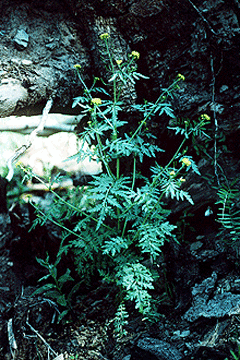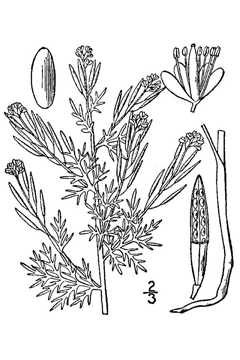 |
|
|
 |
| USDA-NRCS PLANTS Database / Britton, N.L., and A. Brown. 1913. An illustrated flora of the northern United States, Canada and the British Possessions. Vol. 2: 171. |
Translate this page:
Summary
Physical Characteristics

 Descurainia incana is a ANNUAL/BIENNIAL growing to 1 m (3ft 3in). It is in flower from June to August, and the seeds ripen from August to September. The species is hermaphrodite (has both male and female organs). The plant is self-fertile.
Descurainia incana is a ANNUAL/BIENNIAL growing to 1 m (3ft 3in). It is in flower from June to August, and the seeds ripen from August to September. The species is hermaphrodite (has both male and female organs). The plant is self-fertile.
Suitable for: light (sandy), medium (loamy) and heavy (clay) soils. Suitable pH: mildly acid, neutral and basic (mildly alkaline) soils. It can grow in semi-shade (light woodland) or no shade. It prefers dry or moist soil.
UK Hardiness Map
US Hardiness Map
Synonyms
D. richardsonii. (Sw.)Schulz. Sophia incisa.
Plant Habitats
Cultivated Beds;
Edible Uses
Edible Parts: Leaves Seed
Edible Uses:
Young leaves - cooked. A bitter taste[85]. Seed - raw or cooked[46, 105]. The seed can be used as a mustard substitute in soups, stews etc. It can be roasted, ground into a powder then mixed with water to make a fine batter and drunk[257]. The seed is also ground into a meal and mixed with cereal flours when making bread, or as a thickening for soups etc[61, 85].
References More on Edible Uses
Medicinal Uses
Plants For A Future can not take any responsibility for any adverse effects from the use of plants. Always seek advice from a professional before using a plant medicinally.
Poultice
The plant has been used as a lotion for parts of the body that have become frozen in the cold and also as a lotion for sore throats[257]. No more information is given, but it is likely that the crushed seed was used for this since, being similar to mustard, it will probably have a rubefacient effect upon the skin, drawing more blood to that area of the body and thereby heating it[K]. The plant is mashed and applied to bad cuts[257].
References More on Medicinal Uses
The Bookshop: Edible Plant Books
Our Latest books on Perennial Plants For Food Forests and Permaculture Gardens in paperback or digital formats.

Edible Tropical Plants
Food Forest Plants for Hotter Conditions: 250+ Plants For Tropical Food Forests & Permaculture Gardens.
More

Edible Temperate Plants
Plants for Your Food Forest: 500 Plants for Temperate Food Forests & Permaculture Gardens.
More

More Books
PFAF have eight books available in paperback and digital formats. Browse the shop for more information.
Shop Now
Other Uses
References More on Other Uses
Cultivation details
We have almost no information on this species but since it is a casual in Britain there should be no problems in cultivating it here and it is probably not too fussy about soil or situation. We suggest growing it in a dry to moist soil in a sunny position. There is some confusion as to the correct name for this species with some authorities using the name D. richardsonii.
References Carbon Farming Information and Carbon Sequestration Information
Temperature Converter
Type a value in the Celsius field to convert the value to Fahrenheit:
Fahrenheit:
The PFAF Bookshop
Plants For A Future have a number of books available in paperback and digital form. Book titles include Edible Plants, Edible Perennials, Edible Trees,Edible Shrubs, Woodland Gardening, and Temperate Food Forest Plants. Our new book is Food Forest Plants For Hotter Conditions (Tropical and Sub-Tropical).
Shop Now
Plant Propagation
Seed - sow spring in situ.
Other Names
If available other names are mentioned here
Native Range
NORTHERN AMERICA: Canada (Northwest Territories, Yukon, Québec, Ontario, Newfoundland and Labrador, Saskatchewan, Alberta, Manitoba, British Columbia), United States (Alaska, Maine, Kansas, Minnesota, North Dakota, South Dakota, Colorado, Idaho, Montana, Washington, New Mexico, Arizona, California, Utah), Mexico (Baja California (Norte), Chihuahua)
Weed Potential
Right plant wrong place. We are currently updating this section.
Please note that a plant may be invasive in one area but may not in your area so it's worth checking.
Conservation Status
IUCN Red List of Threatened Plants Status :

Growth: S = slow M = medium F = fast. Soil: L = light (sandy) M = medium H = heavy (clay). pH: A = acid N = neutral B = basic (alkaline). Shade: F = full shade S = semi-shade N = no shade. Moisture: D = dry M = Moist We = wet Wa = water.
Now available:
Food Forest Plants for Mediterranean Conditions
350+ Perennial Plants For Mediterranean and Drier Food Forests and Permaculture Gardens.
[Paperback and eBook]
This is the third in Plants For A Future's series of plant guides for food forests tailored to
specific climate zones. Following volumes on temperate and tropical ecosystems, this book focuses
on species suited to Mediterranean conditions—regions with hot, dry summers and cool, wet winters,
often facing the added challenge of climate change.
Read More
Expert comment
Author
(Bernh. ex Fisch.&C.A.Mey)Dorn.
Botanical References
60274
Links / References
For a list of references used on this page please go here
Readers comment
| Add a comment |
|
If you have important information about this plant that may help other users please add a comment or link below. Only comments or links that are felt to be directly relevant to a plant will be included. If you think a comment/link or information contained on this page is inaccurate or misleading we would welcome your feedback at [email protected]. If you have questions about a plant please use the Forum on this website as we do not have the resources to answer questions ourselves.
* Please note: the comments by website users are not necessarily those held by PFAF and may give misleading or inaccurate information.
To leave a comment please Register or login here All comments need to be approved so will not appear immediately.
|
Subject : Descurainia incana
|
|
|
|